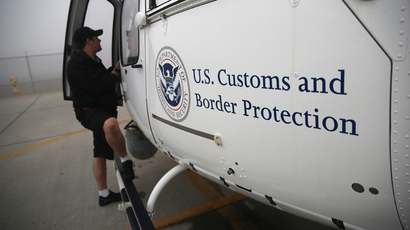Border agents criticized for use of deadly force in report agency shielded from Congress

US Border Patrol agents have purposely stepped in front of moving cars to justify shooting at drivers and used firearms against people throwing rocks across the border from Mexico, according to an independent review of 67 cases that resulted in 19 deaths.
A report by law enforcement experts chastised the Border Patrol for substandard investigations following cases where US agents fired their weapons. The review panel also said that it could not determine whether the Border Patrol “consistently and thoroughly reviews” instances where deadly force was used.
The report was completed in February 2013, but the US Customs and Border Protection (CBP) – the Border Patrol’s parent agency that commissioned the independent review – has thus far blocked the contents from public view. Even US House and Senate oversight committees could not compel the agency to hand over the entire report. The Los Angeles Times has now obtained the full report and the CBP’s response.
The review was conducted by the Police Executive Research Forum, a nonprofit research and policy organization in Washington. The group was offered Border Patrol case files on 67 shooting incidents from January 2010 to October 2012.
The researchers found evidence of border agents at times deliberately blocking a car’s path in order to shoot at drivers who were attempting to avoid arrest but were not a direct threat to anyone.
"It is suspected that in many vehicle shooting cases, the subject driver was attempting to flee from the agents who intentionally put themselves into the exit path of the vehicle, thereby exposing themselves to additional risk and creating justification for the use of deadly force," the report reads. There were times when "passengers were struck by agents' gunfire."
To avoid creating danger where there is little, the report recommends agents be trained to “get out of the way… as opposed to intentionally assuming a position in the path of such vehicles."
Authors suggest border agents not shoot at moving vehicles, just as most US law enforcement are instructed, unless deadly force is being used “by means other than a moving vehicle.”
The internal report obtained by the Times did not detail the number of shooting incidents in response to rock throwing, yet some accounts have been reported by local news.
For instance, in September 2012 Guillermo Arevalo Pedroza, 36, was shot and killed while attending a family picnic on the Mexican side of the Rio Grande River. Officials said the border agent that shot from a patrol boat claimed he was hit by rocks.
A US Department of Homeland Security Office of Inspector General report in September found that border agents shot at rock throwers 22 times in fiscal year 2012, though it did not include if there were any casualties. CBP is part of the Department of Homeland Security.
Mexican officials have voiced frustration that US border agents who kill Mexicans are rarely disciplined, or, if they are, such investigations are kept hidden for years after completion.
In a recent congressional hearing, the CBP was criticized for not disclosing protocols regarding agents’ use of deadly force.
"When a young person throws a rock across the border, toward the border or border agents, some agents respond with a gun and other agents don't respond at all. There seems to be some need for some consistency in the response to these incidents and how we treat it," Sen. Robert Menendez said at a Jan. 15 confirmation hearing for the Obama administration’s nominee to lead CBP, Gil Kerlikowske.
The Border Patrol has started testing “less lethal” weapons like pepper spray, rubber bullets, and Tasers, while instructing new agents on how to deal with violent confrontations, the Times reported. The agency also now tracks shooting incidents in a database to help with crime trends and policy adjustments.
The research group offered two main recommendations: prohibit border agents from firing on vehicles unless their lives are in grave danger, and barring agents from shooting at anyone throwing objects that cannot inflict serious physical injury.
The CBP’s response rejected both suggestions. The agency said a ban on firing at rock throwers “could create a more dangerous environment” given agents often operate in desolate areas where taking cover is next to impossible. The agency added that announcing a Border Patrol policy to not use such force would embolden drug smugglers to attempt to run over agents.
Border Patrol Chief Mike Fisher told the AP in November the CBP viewed the recommendations as “very restrictive.”
"We shouldn't have carve-outs in our policy and say, except for this, except for that," Fisher said. "Just to say that you shouldn't shoot at rock-throwers or vehicles for us, in our environment, was very problematic and could potentially put Border Patrol agents in danger."
Yet Jeh Johnson – head of the Homeland Security Department – is “reconsidering the response” to the report’s suggestions, a department official told the Times on Wednesday.














